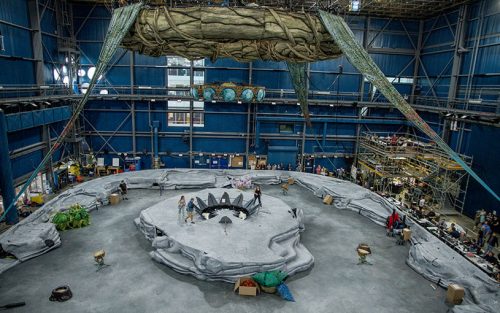Last April, Pennsylvania-based Tait Towers began building the stage and set for Toruk – The First Flight. The challenge was to bring planet Pandora to life, just as set designer Carl Fillion had imagined it, while staying on schedule.
Tait’s 600 employees are the artisans behind a large number of live performance stages, architectural structures and theatres worldwide.
They had already built colossal stages for the Rolling Stones and Lady Gaga, designed structures for the Olympic ceremonies in London and Sochi, and made dreams come true at the Shanghai World Expo.
Even though Cirque du Soleil and Tait have already collaborated on other shows, it’s the first time that Tait gets fully involved in the creation process. “It’s a privilege,” says Tait project manager Scott Levine. “I let them know how the project is coming along, and we work together on technical, logistic and artistic challenges and solutions.”
Scott works closely with Toruk – The First Flight set designer Carl Fillion. “I’ve spent so much time with Carl, that I can now order lunch for him without having to worry about whether he’ll like it or not,” jokes Levine.
All that time spent together is necessary to “make sure that we maintain our artistic vision of the show… and that we work within the various constraints.”
“In order to comprehend the true nature of a project, we first need to define the roles of special effects and stage props,” says Scott. “It’s even more important than the building design because each scenic piece can be built in different ways.” Tait then makes suggestions regarding building methods, materials or even paint colors.
Scenic elements are huge but are able to be transported from an arena to another.
In Toruk – The First Flight, for example, the structure surrounding the stage and the central island are meant to hide objects and plants that will make a later appearance in the show. For that purpose, Tait designed a system of pneumatic openings.
These two designs also need to add relief to the stage and give the impression of a mountainside. They are thus covered in synthetic foam, which gives the illusion of a “wonderful rocky ground,” says Levine.
The show also needs to be easily taken apart to be moved from one city to another. “Most of the scenic dressing the audience sees are in fact inflatable,” adds Levine. “That’s what enables us to build huge structures and still be able to transport them.”
It’s incredible to think that all that foam, plastic, steel and fabric will come together to become tall trees and steep cliffs, and an extraordinary planet where dreams do come true.
{ SOURCE: CirqueClub | https://goo.gl/E41Bms }
